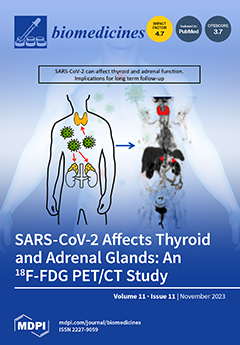Benzofuran, 1,3,4-oxadiazole, and 1,2,4-triazole are privileged heterocyclic moieties that display the most promising and wide spectrum of biological activities against a wide variety of diseases. In the current study, benzofuran-1,3,4-oxadiazole
BF1–
BF7 and benzofuran-1,2,4-triazole compounds
BF8–
BF15 were tested against HCV
[...] Read more.
Benzofuran, 1,3,4-oxadiazole, and 1,2,4-triazole are privileged heterocyclic moieties that display the most promising and wide spectrum of biological activities against a wide variety of diseases. In the current study, benzofuran-1,3,4-oxadiazole
BF1–
BF7 and benzofuran-1,2,4-triazole compounds
BF8–
BF15 were tested against HCV NS5B RNA-dependent RNA polymerase (RdRp) utilizing structure-based screening via a computer-aided drug design (CADD) approach. A molecular docking approach was applied to evaluate the binding potential of benzofuran-appended 1,3,4-oxadiazole and 1,2,4-triazole
BF1–
BF15 molecules. Benzofuran-1,3,4-oxadiazole scaffolds
BF1–
BF7 showed lesser binding affinities (−12.63 to −14.04 Kcal/mol) than benzofuran-1,2,4-triazole scaffolds
BF8–
BF15 (−14.11 to −16.09 Kcal/mol) against the HCV NS5B enzyme. Molecular docking studies revealed the excellent binding affinity scores exhibited by benzofuran-1,2,4-triazole structural motifs
BF-9 (−16.09 Kcal/mol),
BF-12 (−15.75 Kcal/mol), and
BF-13 (−15.82 Kcal/mol), respectively, which were comparatively better than benzofuran-based HCV NS5B inhibitors’ standard reference drug Nesbuvir (−15.42 Kcal/mol). A molecular dynamics simulation assay was also conducted to obtain valuable insights about the enzyme–compounds interaction profile and structural stability, which indicated the strong intermolecular energies of the
BF-9+NS5B complex and the
BF-12+NS5B complex as per the MM-PBSA method, while the
BF-12+NS5B complex was the most stable system as per the MM-GBSA calculation. The drug-likeness and ADMET studies of all the benzofuran-1,2,4-triazole derivatives
BF8–
BF15 revealed that these compounds possessed good medicinal chemistry profiles in agreement with all the evaluated parameters for being drugs. The molecular docking affinity scores, MM-PBSA/MM-GBSA and MD-simulation stability analysis, drug-likeness profiling, and ADMET study assessment indicated that
N-4-fluorophenyl-
S-linked benzofuran-1,2,4-triazole
BF-12 could be a future promising anti-HCV NS5B RdRp inhibitor therapeutic drug candidate that has a structural agreement with the Nesbuvir standard reference drug.
Full article






